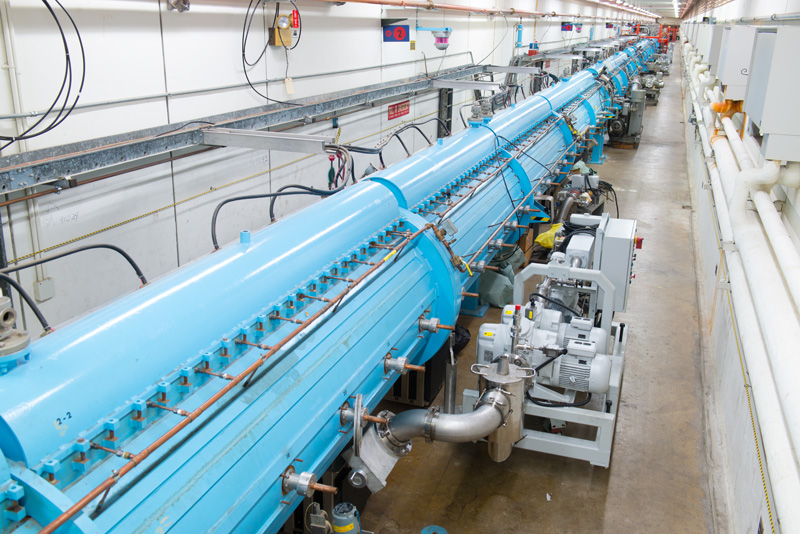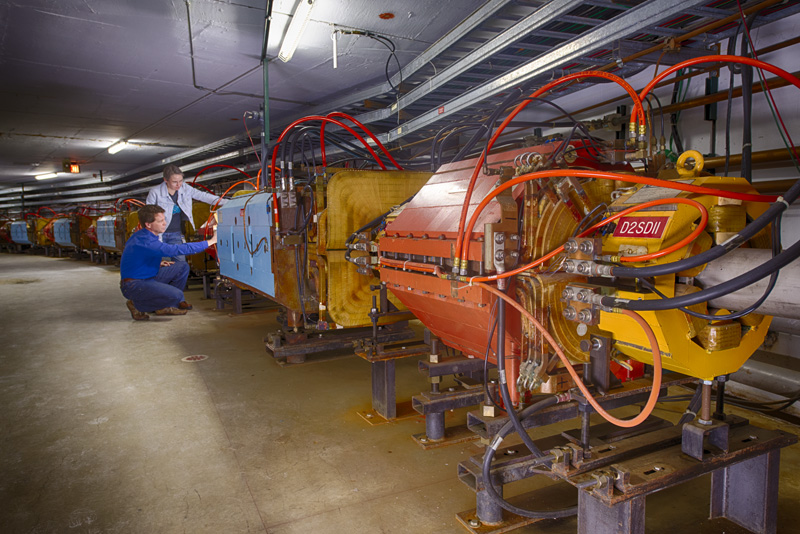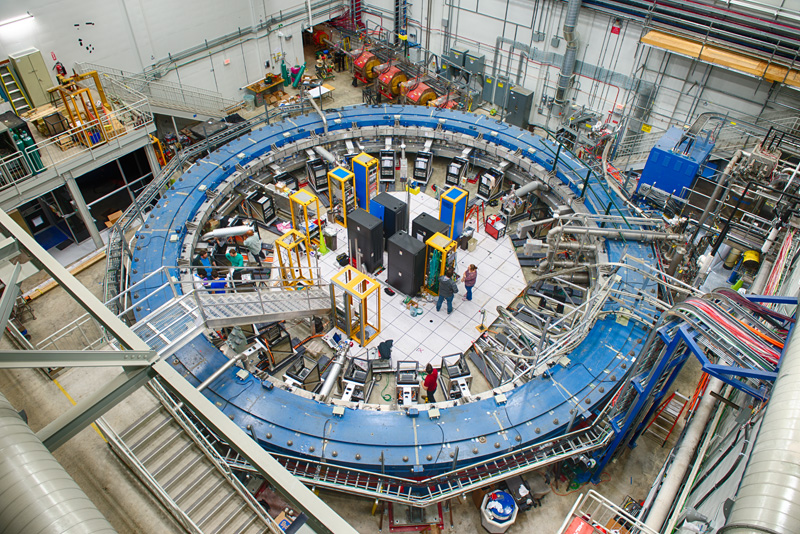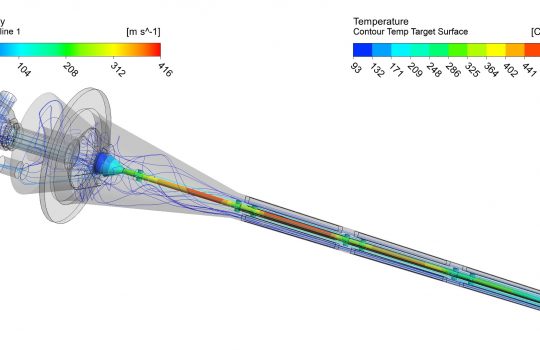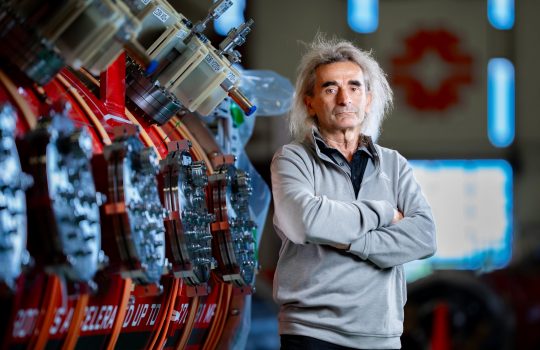It’s a moment that many at Fermilab have been waiting for: After a period of maintenance, construction, upgrades and repairs, every one of the laboratory’s nine particle accelerators is in run mode as of this publication. This means that all four of the accelerators in the lab’s main accelerator chain are running, as are both machines for the Muon g-2 experiment; both of the machines for the lab’s accelerator science program; and the lab’s applications-focused accelerator.
With the lab firing on all accelerator-cylinders, it’s a good time to provide a rundown of each member of Fermilab’s accelerator complex, from the oldies to the newest machine.
Since the lab’s inception in 1967, the family of particle accelerators that call Fermilab home has gone through many changes. Fermilab’s rich history of scientific discoveries began with the construction of the four-mile-circumference Main Ring in the early 1970s, followed by the installation of the game-changing Tevatron particle collider, which ran until 2011. Now the lab is in an era of neutrino and muon physics, and several of its accelerators and storage rings have been reconfigured to deliver new and more intense beams for numerous experiments.
Today, no fewer than nine main accelerators power technological advances and groundbreaking discoveries at Fermilab.
Linear accelerator (Linac)
- Shape: Linear
- Size: 140 meters
- Built: First operated in 1970, upgraded in 1992. New front end — a radio-frequency quadrupole — added in 2012. Major power upgrade in 2018.
- Energy boost: Up to 400 MeV (from original 200 MeV in the 1970s)
- Accelerated particles: Hydrogen ions
- Purpose: Creates initial acceleration of particles for Fermilab’s chain of particle accelerators; feeds Booster.
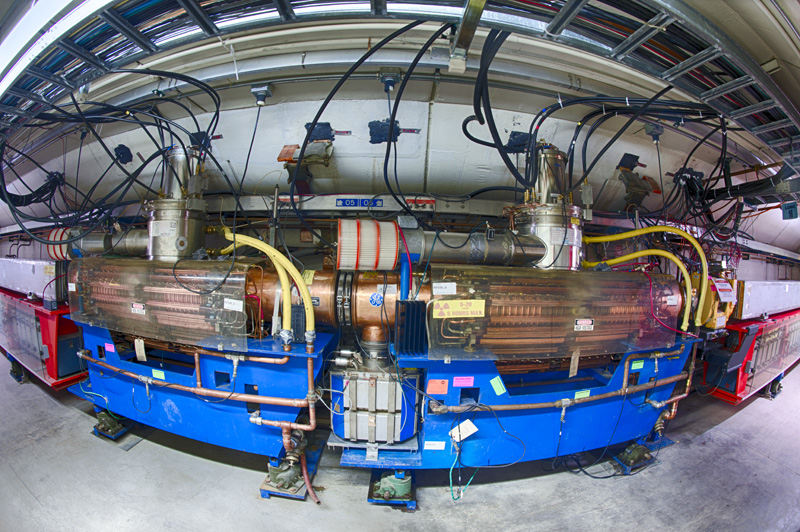
Beam from the Linac feeds the Booster, seen here. It sends beam to the Recycler and, in the future, will send low-energy beams to the Short-Baseline Neutrino experiments. Photo: Reidar Hahn
Booster
- Shape: Circular
- Size: 474 meters in circumference (1/7 that of the Main Injector; see below)
- Built: First reached full energy in 1971; upgrades for 15-hertz beam completed in 2018
- Energy boost: up to 8 GeV
- Accelerated particles: Protons
- Purpose: Strips electrons from hydrogen ions provided by the Linac, leaving protons. Gives further energy boost to proton beam to feed into Recycler. Provides protons for the production of muon beams for Muon g-2 and upcoming Mu2e. Also provides protons for production of low-energy neutrino beam for MicroBooNE, with two more detectors under construction: ICARUS and SBND (all part of the Short-Baseline Neutrino Program).
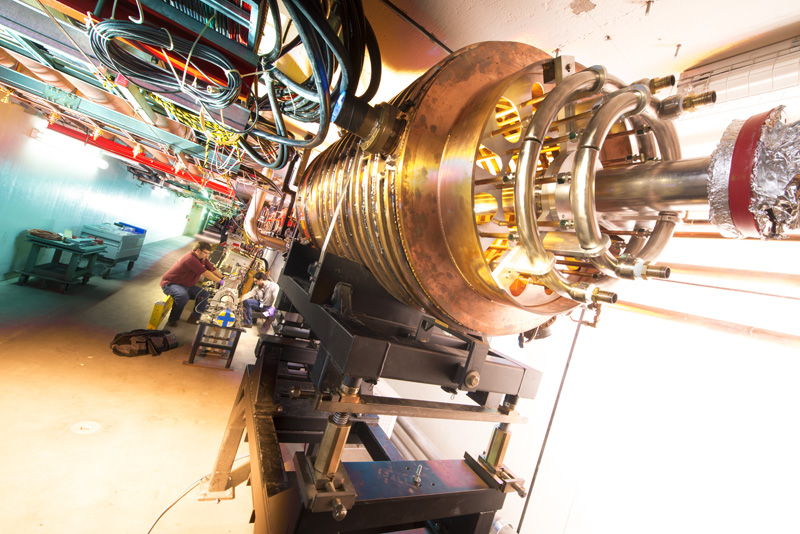
The Recycler receives beam from the Booster, sending some to the next accelerator stage and some to the lab’s muon experiments. Photo: Reidar Hahn
Recycler
- Shape: Circular
- Size: 3.3 kilometers in circumference
- Built: Completed in 1999
- Energy boost: N/A (stores protons at 8 GeV)
- Stored particles: Protons
- Purpose: Originally used for antiproton cooling and storage for Tevatron, converted to proton beam use in 2013. Combines bunches of protons in beam to increase intensity – a process known as “slip stacking.” Feeds Main Injector, located in same tunnel, below the Recycler. Also provides protons to produce muons (working with Muon Delivery Ring, below) for Muon g-2 and Mu2e experiments.

The Main Injector is the lab’s flagship accelerator, sending high-power beams to multiple experiments. Photo: Reidar Hahn
Main Injector
- Shape: Circular
- Size: 3.3 kilometers in circumference
- Built: Completed in 1999
- Energy boost: 8 GeV to 120 GeV
- Accelerated particles: Protons
- Purpose: Provides protons (at some of the world’s highest intensities) to create neutrino beams for NOvA and upcoming LBNF/DUNE. Sends protons to Fermilab Test Beam Facility. Until 2011, provided protons to antiproton ring and Tevatron.
Muon Delivery Ring
- Shape: Circular
- Size: 500 meters in circumference
- Built: Originally built in 1983 as Debuncher Ring for the Antiproton Source; renamed in 2012, modification completed in 2017
- Energy boost: N/A
- Stored particles: Protons, pions, muons
- Purpose: Provides beam for Muon g-2 and, in the future, Mu2e experiment. Proton beam from Recycler smashes into target to produce pions, which decay into muons for use in Muon g-2 experiment. For Mu2e experiment, will deliver protons.
Muon g-2 storage ring
- Shape: Circular
- Size: 50 meters in circumference
- Built: 1996 at Brookhaven National Laboratory; dismantled and shipped to Fermilab in 2013; full reassembly complete in 2017
- Energy boost: N/A (stores muons at 3.1 GeV)
- Stored particles: Muons
- Purpose: Store muons for the Muon g-2 experiment.
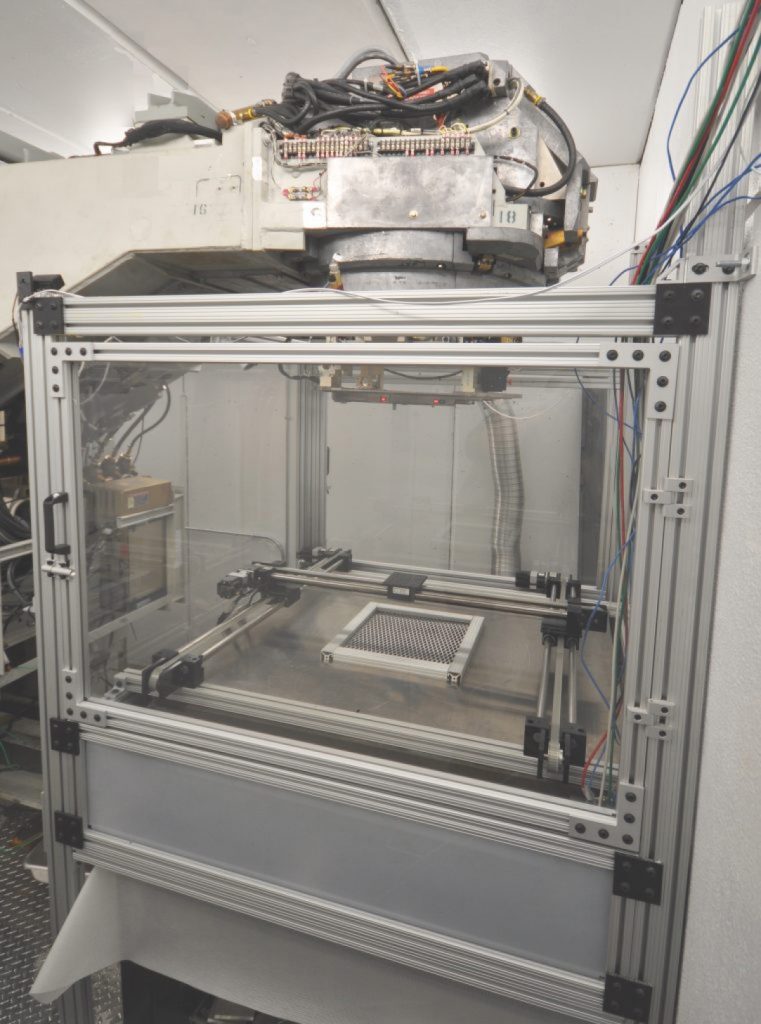
The A2D2 accelerator enables the exploration of industrial applications for particle beams. Photo: Mike Geelhoed
A2D2 compact accelerator
- Shape: Linear
- Size: Compact
- Built: 1996. Started up at Fermilab in 2017
- Energy boost: up to 9 MeV
- Accelerated particles: Electrons
- Purpose: Provides platform to investigate how electron beams can be used in industrial applications and better develop specific processes.
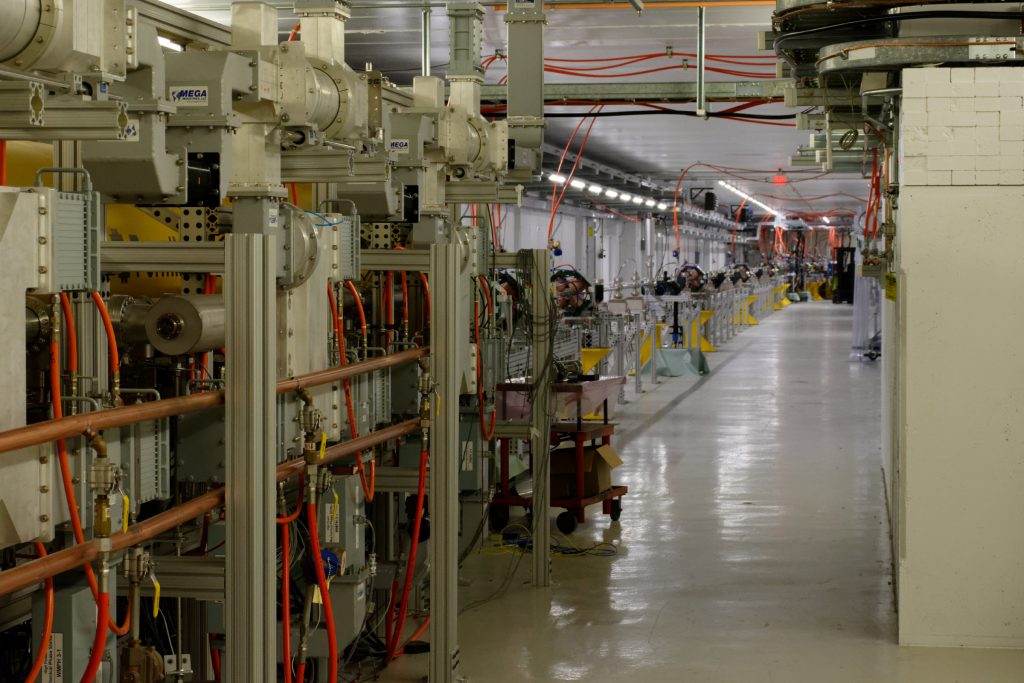
The electron injector at the Fermilab Accelerator Science and Technology facility prepares electrons for IOTA. Photo: Giulio Stancari
FAST electron injector
- Shape: Linear
- Size: 125 meters
- Built: 2012, upgraded in 2017
- Energy boost: up to 300 MeV (achieved November 2017)
- Accelerated particles: Electrons
- Purpose: Provides beam for IOTA accelerator at FAST facility, which will test new accelerator technologies.
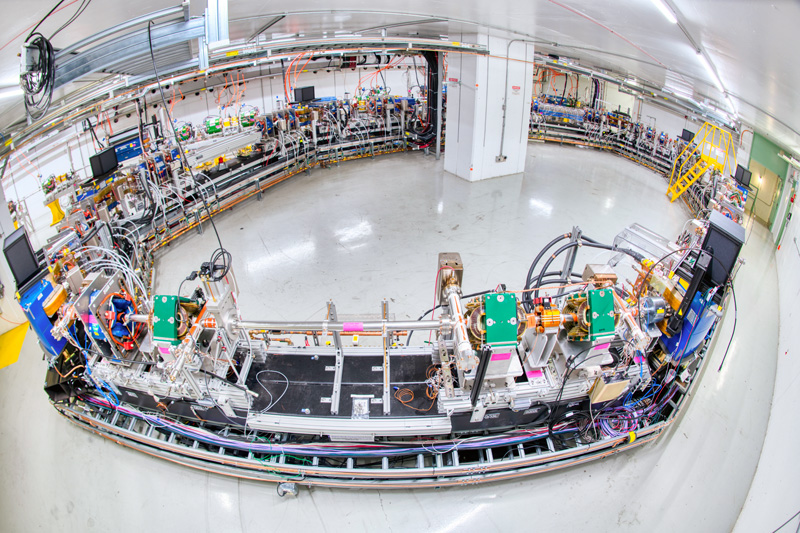
The IOTA ring currently stores electrons; in the future, it will also circulate protons. Photo: Reidar Hahn
IOTA storage ring
- Shape: Circular
- Size: 40 meters in circumference
- Built: 2018
- Energy boost: N/A (stores electrons at 100-150 MeV; in the future, will be capable of storing protons at 2.5 MeV)
- Accelerated particles: Will be able to store proton beams in the future
- Purpose: Stores electrons (and in the future, protons) to test new accelerator technologies.

